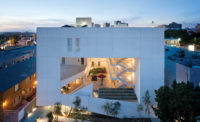| Photo © Jeff Amram |
|
Mercy Corps Headquarters by THA Architecture. Click on the tab to view more images. |
Today, the American Institute of Architects’s Committee on the Environment (AIA–COTE) announced its Top Ten projects for 2012. This year’s batch of winners highlight community ties, social equity, and attentiveness to water issues. Notably, one winner is designed to Passive House standards. “These projects really demonstrate that you don’t need a client with bottomless pockets or a purely pedagogical mission related to sustainability,” wrote one juror. Another juror emphasized the enduring importance of buildings that inspire people and connect neighborhoods: “It is the true measure of sustainability—the fact that a project becomes so embraced by its community that its value far exceeds the value of a conventionally designed building.”
2012 AIA-COTE Award Winners
1315 Peachtree Street, Perkins+Will
This project entailed the transformation of a conventional 1986 building in Atlanta into a high-performance office space and demonstration project incorporating daylighting, an open office plan, rainwater catchment, high-performance glazing, and photovoltaics. Reducing reliance on the region’s coal-dominated energy mix through a grid-tied trigeneration system (combined heating, cooling, and power) helped the project achieve aggressive carbon targets.
ASU Polytechnic Academic District, Lake|Flato Architects
This pedestrian-oriented campus in Mesa, Arizona, replaced a decommissioned Air Force base. The design team resolved longstanding flooding issues by supplanting 14 acres of asphalt and concrete with naturalized habitats. “Extroverted circulation” in protected atria and courtyards optimizes the available space, providing outdoor connections and gathering spaces while also reducing construction costs and minimizing the amount of impervious surface.
Chandler City Hall, SmithGroupJJR
The team behind this municipal building strove to reinvigorate a Phoenix suburb’s historic downtown by bringing the city government into one central building. The goal: to foster community identity and seed economic development. Community art projects integrated within the building and site bring awareness to sustainability features.
Hood River Middle School Music and Science Building, Opsis Architecture
New gardens, a greenhouse, onsite wastewater treatment, and other permaculture strategies advance the goals of an established outdoor education program at this public middle school in Hood River, Oregon. Students have access to the ground-source pump room as well as sub-metered energy data, and the science curriculum integrates aspects of energy and water budgets through hands-on experiments involving building performance.
Iowa Utilities Board Office of Consumer Advocate, BNIM
A singular focus on responsible use of resources—both natural systems and taxpayer funds—led to this ultra-high-performance building in Des Moines, Iowa, that boasts an energy use intensity of 22 kBtu/ft2. In a state that has experienced a number of recent devastating floods, stormwater management was a prime consideration; native prairie habitat re-established over infiltration basins treats stormwater on site while also serving as green space.
Kensington High School for the Creative and Performing Arts, SMP Architects
This transformative project in Philadelphia, spearheaded by a local youth group, remediated a blighted former train yard that had become a haven for drug dealers and wild dogs, according to the design team. The site is now a thriving public high school bordered by a neighborhood park filled with production gardens, rain gardens, and fields. Truancy at the school has plummeted, and graduation rates have skyrocketed. As one student reportedly wrote in a poem during a 2011 Earth Day event, “I was born into poverty. I am poor now, but I am no longer without hope.”
Mercy Corps Headquarters, THA Architecture
Determined to live out its mission to promote community renewal after disaster or hardship, Mercy Corps chose to bring new life into a neighborhood through the revitalization of the Packer-Scott Building, a historic landmark in Portland, Oregon. The urban location allows 75 percent of employees to arrive by alternative transportation, prompting the need to expand bicycle storage facilities in the near future.
Portland Community College Newburg Center, Hennebery Eddy Architects
This student center is the first building constructed as part of a planned net-zero-energy community college campus in Newburg, Oregon. Careful design of the natural ventilation system eliminated the need for mechanical cooling, while daylighting and passive solar heating strategies reduce energy use. To ensure net-zero performance, the staff is engaged in intensive post-occupancy energy tracking.
University of California–Merced Campus, UC–Merced
With a focus on social equity, economic sustainability, and environmental responsibility, this developing campus aims to be the first in the United States to achieve net-zero energy, carbon emissions, and waste. The jury commended the project for its commitment to monitoring system performance. “We are moving toward a world of outcome-based codes,” wrote one juror. “This project does us all a service in helping to show the way.”
University of Minnesota–Duluth Classroom Building, Salmela Architect
This classroom building is the first AIA–COTE Top Ten project we’ve seen built to Passive House performance standards. Passive solar heat gain supplies almost all the heating energy in winter, while super-insulation ensures that the building can stay warm for several days without power or direct sunlight. The structure provides a gateway to the university’s nature preserve and includes an outdoor classroom area that minimized the building’s footprint.
2012 AIA-COTE Award Jurors
Sue Barnett
Clark Brockman
Steve Dumez
Laura Lee
Scott Shell
Paul Schwer
For more information about the winners, visit the AIA’s COTE website.
Updated: Laura Lee (not Vivian Loftness) was part of the 2012 AIA-COTE Award Jury.











